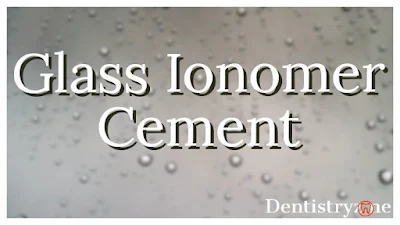What is Glass Ionomer Cement (GIC)? Glass ionomer cement (GIC) is the restorative material used for restoring carious teeth. It ...
What is Glass Ionomer Cement (GIC)?
Glass ionomer cement (GIC) is the restorative material used for restoring carious teeth. It is an adhesive and tooth coloured restorative material. It is highly used in the restoration of carious teeth involving the anterior teeth due to its high esthetic in nature compared to amalgam restoration. It also possesses an anti-cariogenic property that prevents secondary caries. It is called glass ionomer cement because the composition contains glass particles and it attaches to the tooth by employing an ionic bond. It is also called man-made dentin, polyalkeonate cement and Alumini Silica Polyacrylic Acid (ASPA). Its ADA specification number is 96.
Composition of GIC
It consists of powder and liquids. Both are mixed to get GIC and restore the carious tooth.
Powder
Silica ( glass particles)
Alumina
Aluminium fluoride
Calcium fluoride
Sodium fluoride
Aluminium phosphate
Lanthanum, strontium,
Fluoride
Ceramic flux
Liquid
Polyacrylic acid- consists of 45%
Water- consists of 50%
Itaconic acid, Maleic acid, Tricarballylic acid and Tartaric acid consists of 5%.
Types of Glass ionomer cement
According to the Usage,
Type I - used for luting
Type II - used for restoration
Type III - used as liners and bases
Type IV - used as pit and fissure sealants
Type V - used as luting for orthodontic purposes
Type VI - used for core buildups
Type VII - High fluoride-releasing
Type VIII - used as Atraumatic restorative material
Type XI - used in Pediatric dentistry
Some other classifications are,
Traditional GIC
Type I, Type II, and Type III GIC's
Metal modified GIC
Miracle mix
Cermet cement
Light cure GIC
HEMA
Resin modified GIC
It is also known as a Hybrid glass ionomer. The composite resin contains glass particles.
How to Apply Glass ionomer cement?
Before we applying GIC, we make sure to keep the operating field free from moisture. Because glass ionomers are sensitive to it. The proper power-liquid ratio would be followed, it may vary on the brands you use. So make sure it by seeing the catalogue of your brand. Let us see the procedure,
Dispense the preferred ratio of powder and liquid in the paper pad. In the paper pad only we can mix GIC, it cannot be mixed in the glass slab like zinc phosphate cement. Because the powder of the GIC contains already Silica particles and the Glass slab too contains silica particles so it affects the chemical interaction between the powder and the liquid of GIC.
After dispensing, the powder should be divided into two equal parts and rapidly introduced into the liquid with the help of a plastic spatula.
The first part of the powder is mixed with liquid within the first 5-15 seconds and the second part of the powder is mixed within the next 20 seconds. Finish the mixing procedure within 45-60 seconds. It should not exceed it.
Final mixing should have a glossy surface. The working time is about 2 minutes and the final setting time is 7 minutes.
Clinical applications of GIC
It is used as luting of fixed prosthesis. In the sandwich technique, it is used as a base under composite restoration. In the restoration of Class V cavities. In the Pediatric Dentistry as pit and fissure sealants.
Advantages of Glass Ionomer Cement (GIC)
As mentioned earlier, it is tooth coloured material so it won't affect our aesthetics. It has high anti-cariogenic property Chemical bonding to the tooth. So there is conservation of sound tooth structure during cavity preparations, unlike amalgam restoration. It has less microleakage.
Disadvantage of Glass Ionomer Cement (GIC)
The main drawback of GIC is they are less resistant to wear. So it won't generally be recommended in the occlusal surface of posterior teeth where there are high masticatory forces.
Modifications of Glass Ionomer Cement (GIC)
These varieties of GIC are obtained by mixing with other metals or chemicals. They are,
Metal modified GIC
Resin modified GIC
High viscosity GIC
Calcium aluminate GIC
Compomer
Metal modified GIC
It consists of Miracle mix and Cermet.
Miracle mix
It is obtained by adding silver alloy powder to the powder of GIC. Due to this addition, the restoration is resistant to fracture and hardness. The main disadvantage is their poor aesthetics. It is also referred to as silver alloy admix.
Cermet
It is obtained by sintering silver alloy particles at very high temperature with powdered glass. It has good wear resistance. Fluoride release is less compared to that of miracle mix.
Resin modified GIC
HEMA (Hydroxyethyl methacrylate) is added to the polyacrylic acid. It is light-activated glass ionomer cement. Camphoroquinone is added as the photoinitiator to the powder. Setting reaction is controlled and increased bond strength. Here setting reaction is activated by light.
High viscosity GIC
It contains smaller glass particles that assist in higher viscosity. It has greater compressive strength. It requires a high quantity of powder-liquid ratio.
Compomer
Composite + Glass Ionomer Cement = Compomer.
Composite is predominant in compomer with less addition of GIC.
Calcium aluminate GIC
By the name, we conclude that it is the addition of Calcium aluminate and GIC. It is mainly used as luting for fixed prosthesis.










COMMENTS